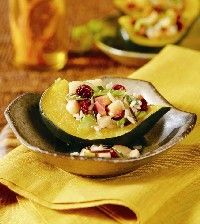 “Learn how to enjoy holiday eating, even as a diabetic.See more pictures of enlightened desserts.©2006 Publications International, Ltd.
“Learn how to enjoy holiday eating, even as a diabetic.See more pictures of enlightened desserts.©2006 Publications International, Ltd.
The holidays can be a challenging time of year for people who are trying to watch what they eat. If you have diabetes, the challenge becomes even greater. Don’t despair, though.
This article offers plenty of suggestions on how to enjoy all of your favorite holiday treats while still sticking to your diet. You’ll find information on:
Healthful Holiday Eating
Learn food-preparation techniques, such as substituting apple cider for butter or fat when basting a turkey, and tips like eating a small snack before dinner so you won’t overdo it at mealtime. This section also includes helpful suggestions on how to throw a healthful holiday party for children with diabetes. You’ll be ready to face the holidays with gusto after reading this!
Diabetes and Drinking
People with diabetes — as well as people who don’t have the disease — should always be mindful of their alcohol intake. The holidays can be a greater challenge thanks to eggnog, champagne, and the overall holiday revelry. This section provides a helpful chart that lists the calorie carbohydrate counts of many popular drinks.
Creating an Elegant Holiday Feast
Just because it’s the holidays doesn’t mean you can’t eat healthy food. This section offers an incredible menu for a holiday feast, complete with delectable appetizers, a mouth-watering entree (including side dishes), and even a calorie-conscious dessert. Included are links to diabetic holiday recipes and a handy shopping list that will make your prep work go smoothly.
Let’s first take a look at some helpful ways to find holiday foods that are both good to eat and good for you. You’ll find this information on the next page.
Healthful Holiday Eating
 “Your family can celebrate with the holiday favorites.©2006 Publications International, Ltd.
“Your family can celebrate with the holiday favorites.©2006 Publications International, Ltd.
The holidays are approaching, and we all know that celebrating with family and friends means food — usually lots of it!
You may have heard warnings that the average person gains 5 to 7 pounds during the holiday season. However, researchers from the National Institutes of Health have dispelled this holiday weight-gain myth. They studied 200 men and women from Thanksgiving to New Year’s and found that the average weight gain was closer to about 1 pound.
While this is much less than previously thought, any weight gain is not to be taken lightly — especially when the pounds stick around. A few pounds each holiday season can amount to a considerable weight gain over time, which can pose serious health consequences for people with diabetes.
The holidays may not be the best time to focus on losing weight, but it is realistic to concentrate on not gaining weight. Read on for some tips to help you enjoy the special foods of the season and stay on track with managing your diabetes and your weight.
Balance at the Table
Balance doesn’t mean depriving yourself of holiday favorites. Instead, it means fitting reasonable amounts of holiday foods into your meal plan — a feat that is entirely possible.
One simple way to bring balance to your holiday table is with fruits and vegetables. Packed with nutrients and naturally low in calories, produce provides eating satisfaction with few calories.
For example, serve fresh vegetables and low-fat dips before a meal, and offer fresh fruit salad as a dessert option. A vegetable-based soup is a great starter to help fill you up so you’re less likely to overindulge on main dishes, sides, and desserts.
Feast on Fitness
To make it through the feasting without weight gain, include fitness in all your holiday plans. Use it to help burn off excess calories — and relieve stress at the same time.
It may be a busy time of the year to start or maintain an exercise routine, but it doesn’t mean that you can’t make your other activities, such as shopping, more physical. Take the stairs at the mall instead of the escalator, or park in a remote lot and walk farther.
Remember that physical activity can be planned as part of your family gatherings. Plan a game of basketball or softball for your guests, go skating or sledding before your meal, or take a walk or hike after the meal.
Holiday Sweets
Holidays and sweets go hand-in-hand. These foods must be counted as part of the total carbohydrates that you are allowed each day. This means that sweets and treats shouldn’t simply be added to your diet — rather they should be substituted for other carbohydrates in your meal plan.
This is especially important for people taking insulin to avoid large increases in blood glucose. Your best bet is to talk to your diabetes educator or dietitian about your holiday meal plan. It may mean eating less of other foods, more exercise, increasing medications, or a combination of these.
Holiday Menu Tune-Up
Here are some great food prep tips for holiday cooking for people with diabetes:
 “Wild Rice, Cranberry and Apple Stuffing©2006 Publications International, Ltd.
“Wild Rice, Cranberry and Apple Stuffing©2006 Publications International, Ltd.
- Baste your turkey with fat-free chicken broth or apple cider instead of butter or drippings.
- Use whole-wheat bread cubes instead of white to give stuffing a fiber boost. Or, be adventurous and try a stuffing made with wild rice, brown rice, or bulgur wheat, like Wild Rice, Cranberry and Apple Stuffing.
- Add fiber and extra nutrients to your stuffing or vegetable dishes by tossing in a handful of raisins, dried apricots, or chopped nuts.
- Instead of topping sweet potatoes with butter, sugar, and marshmallows, try tossing your sweet potatoes in a small amount of oil, sprinkling on some cinnamon and roasting them until caramel brown.
- Use fruit butter or pumpkin butter as a low-cal bread spread.
- Make your pumpkin pie with fat-free evaporated milk instead of whole evaporated milk — a simple way to slice off 200 calories and nearly 30 grams of fat from a pumpkin pie.
- Try cutting sugar by one-third to one-half in traditional dessert recipes and increase the use of flavorful spices, such as cinnamon, nutmeg, vanilla, and other sweet spices and flavorings. Or, try replacing some of the sugar with a sugar substitute that is suitable for baking.
- When you’re a guest, always peruse the offerings first. Load up on vegetables, add some protein, such as turkey or other meats to help satisfy your appetite, and then fill in with samples of carbohydrate-based foods, such as stuffing, potatoes, or pasta.
- Don’t arrive at a party with an empty stomach. Instead, be sure to eat a light snack or meal beforehand.
- Start with half-size portions and savor every bite. If you’re still truly hungry, you can always go back for seconds. Remind yourself to eat until you’re satisfied, not stuffed.
- Offer to bring a healthful dish to a party. The other guests also may appreciate the choice.
Holiday Fun for Children with Diabetes
Everyone loves a holiday party, especially kids, but the red flag pops up if your party involves children with diabetes. How can they have fun if they’re diet-restricted?
It’s not as hard as you may think. In fact, these parties can be more fun than the typical "junk food marathons." The key is making the entire party fun, and not using the food as the sole form of entertainment.
Kids with diabetes are just that — kids. They can do what all kids should do: Eat a little less sugar, a little less saturated fat, and play more. It’s basically pretty simple. But parties can make you feel overwhelmed, especially if you’re used to simply supplying bagged chips, store-bought cakes, and sugary soft drinks.
When planning for your holiday party, think color, texture, and eye appeal with the serving pieces and the foods, too. Have a variety, be creative, and think fun. For example, serve the Peanutty Banana Dip in hollowed-out red and green apple halves. Use different brightly colored napkins of paper or cloth to line baskets or serve as a fun tablecloth.
It’s also good to get the focus away from the food and toward other entertainment. With help from your child, organize an old-fashioned scavenger hunt, or have a "year-round" plastic-egg hunt, filling the eggs with small holiday trinkets instead of candy.
If you can keep just one thought in mind when planning holiday parties that involve children with diabetes, remember this: Don’t preach or draw unnecessary attention to the "dos and don’ts" of foods. Instead of telling a child, "Eat this because it is good for you," it feels a lot better to hear yourself say, "This is so good, and so much fun!"
Making plans together not only brings the two of you closer; it also lets your child participate in that aspect of the party as well.
Learn more about diabetes and drinking on the next page, which includes a helpful chart that lists the carb and calorie count of some popular drinks.
This information is solely for informational purposes. IT IS NOT INTENDED TO PROVIDE MEDICAL ADVICE. Neither the Editors of Consumer Guide (R), Publications International, Ltd., the author nor publisher take responsibility for any possible consequences from any treatment, procedure, exercise, dietary modification, action or application of medication which results from reading or following the information contained in this information. The publication of this information does not constitute the practice of medicine, and this information does not replace the advice of your physician or other health care provider. Before undertaking any course of treatment, the reader must seek the advice of their physician or other health care provider.
Diabetes and Drinking
 “Moderating your drinking — especially during the holidays — is always a wise choice.©2006 Publications International, Ltd.
“Moderating your drinking — especially during the holidays — is always a wise choice.©2006 Publications International, Ltd.
Does alcohol mix with your holiday meal plan? It’s a bit like juggling a plate, fork, and glass while standing at the buffet table — drinking alcohol is truly a balancing act for people with diabetes. Recent research on alcohol points to both health benefits and risks, based on a number of factors.
One of the most important is weight. For people with diabetes who maintain normal weight, the benefits of moderate alcohol consumption (see sidebar) include lowered risks of cardiac disease, lowered inflammatory responses, and increases in the "good" HDL cholesterol.
Depending on what kind of drink you choose, there are even more perks. Dark beer and red wine contain plant-based flavonoids and other antioxidant compounds with health-protective qualities.
However, people with diabetes who are overweight should avoid alcohol because it adds excess calories to the diet. In addition, alcohol can depress metabolic function and stimulate the appetite.
The universal risks of drinking alcohol are well known: Excessive drinking can lead to alcoholism, and drinking and driving are a truly dangerous combination.
Other possible consequences include physical or emotional deterioration. For example, alcohol increases the risks of low blood sugar for up to 24 hours after drinking. Even moderate amounts of alcohol can trigger high blood pressure and raise triglyceride levels.
Alcohol also can worsen diabetic neuropathy and cause gastric distress. And for women who are in menopause, alcohol may increase the severity of hot flashes.
Alcohol alters mood. It is a central nervous system depressant and makes seasonal sadness worse in those people prone to it. If you get the "holiday blues," it is wise to abstain from alcohol.
Instead, have some purple grape juice or homemade hot cocoa (made with minimal sugar or a sugar substitute). Or have black tea, which has the benefit of extra health-protecting flavonoids.
Here are tips for those who wish to toast the season with a favorite alcoholic beverage:
- Discuss drinking with your doctor and certified diabetes educator before you add alcohol to your meal plan.
- Symptoms of low blood sugar can mimic intoxication, so be extra careful during the holiday season to avoid driving with low blood sugar and/or driving after drinking.
- Know your portion sizes: Goblets may be gorgeous on the holiday table, but some large glasses actually hold double- or triple-serving sizes.
- A snack after drinking helps to maintain blood glucose levels. Be sure to check your blood sugar levels with a monitor after drinking and before bedtime to prevent nighttime lows.
- After careful assessment of your health needs, it’s possible that you can balance moderate alcohol consumption in your eating plan and still control your diabetes. Just be sure to make the right decision for you.
- Remember that whether or not you partake of alcohol, you can still enjoy socializing during the holidays. Bring your own beverage of choice, and join in the toast, "To your health!"
Get in the party-planning mode by learning how to create an elegant holiday feast on the next page.
This information is solely for informational purposes. IT IS NOT INTENDED TO PROVIDE MEDICAL ADVICE. Neither the Editors of Consumer Guide (R), Publications International, Ltd., the author nor publisher take responsibility for any possible consequences from any treatment, procedure, exercise, dietary modification, action or application of medication which results from reading or following the information contained in this information. The publication of this information does not constitute the practice of medicine, and this information does not replace the advice of your physician or other health care provider. Before undertaking any course of treatment, the reader must seek the advice of their physician or other health care provider.
Moderation and Carbs
Moderate drinking consists of 1 serving per day of 12 ounces of beer or 5 ounces of wine or 1-1/2 ounces of distilled spirits.
Because alcohol is used by the body more like a fat than a carbohydrate, 1 serving counts as 2 Fat exchanges under American Diabetes Association guidelines.
Alcohol contains calories and carbs that must be counted in your individual eating plan. Mixed drinks contain additional calories and carbs from sweetened mixes. Here are approximate calories and carbs:
Margarita (7 ounces) 189 calories 15 grams
Beer (12 ounces) 153 calories 13 grams
Vodka (11/2 ounces) 97 calories 0 grams
Wine (5 ounces) 72 calories 2 grams
Read More
Creating an Elegant Holiday Feast
 “Prepare an elegant holiday feast with our diabetes recipes. You’re sure to have a holiday dinner party everyone will love!Publications International, Ltd.
“Prepare an elegant holiday feast with our diabetes recipes. You’re sure to have a holiday dinner party everyone will love!Publications International, Ltd.
Who doesn’t love to be the host or hostess with the mostest? Especially during the holiday season, entertaining for friends and family offers huge rewards.
First, when you cook the food, you know you can eat and enjoy (from both a health and pleasure standpoint) without reservation. For anyone on a special diet, a holiday invitation is something that is truly better to give than to receive.
Second, when you give a holiday dinner party you can indulge your creative fancy: from food that looks beautiful and tastes fabulous to a pretty table or buffet (even if you’re only using color-coordinated paper plates and napkins).
Special touches may include candles in profusion, handwritten place cards with a special message for each guest, or an extra wine glass at every plate filled with water and a single floating flower.
Third, and best of all, you can dazzle everyone with your savoir faire — provided you plan and cook ahead in order to enjoy your own party. (And who hasn’t slaved over the proverbial hot stove all holiday long and wound up feeling more frazzled than festive?)
This special holiday meal has been designed to neatly sidestep any final frenzy. From the shopping list to the game plan, you can prepare in advance the hors d’oeuvres, salad dressing, and dessert while the game hens are marinating in tandoori-style spices.
On the day of the party the only work left is to set the table or the buffet — this meal can be served both as a sit-down dinner or buffet style. Then prepare the Vegetable Rice Confetti while the game hens are roasting. Around this time, just unmold the elegant Strawberry Bavarian Deluxe, garnish, and refrigerate. At dinner time, toss the salad, plate the entree, and voila! Dinner is served. When the meal is finished, the dessert comes onstage as the grand finale.
The recipes for this dinner are generally low in sodium, carbs, fat, and cholesterol (if you remove the poultry skin after it’s cooked), and high in fiber. And, because you will surely want to enjoy a serving of Strawberry Bavarian Deluxe, you’ll want to adjust your carb consumption so you can fit it into your meal plan.
So if you follow the game plan below, you’ll be the host or hostess with the most finesse and the least stress.
Game Plan
Day before the party:
- Go shopping.
- Marinate game hens; refrigerate overnight.
- Make all hors d’oeuvres; arrange on serving plates; refrigerate overnight.
- Make Strawberry Bavarian Deluxe; refrigerate overnight.
- Mix salad dressing; refrigerate covered.
Day of the party:
- Set table or buffet.
- When guests arrive lay out hors d’oeuvres.
- Bake game hens.
- Make Vegetable Confetti Rice.
- Unmold Strawberry Bavarian Deluxe; refrigerate.
- Toss salad with dressing; plate salads.
- Garnish Strawberry Bavarian; return to refrigerator.
- Serve meal buffet style or on individual plates for seated dinner.
- Serve dessert at the table.
- Make coffee and/or tea.
Don’t let your diabetic restrictions restrict your holiday fun and feasting. There are plenty of ways to still enjoy all the delicacies of the season while staying in tune to your diet and your body.
©2006 Publications International, Ltd.
This information is solely for informational purposes. IT IS NOT INTENDED TO PROVIDE MEDICAL ADVICE. Neither the Editors of Consumer Guide (R), Publications International, Ltd., the author nor publisher take responsibility for any possible consequences from any treatment, procedure, exercise, dietary modification, action or application of medication which results from reading or following the information contained in this information. The publication of this information does not constitute the practice of medicine, and this information does not replace the advice of your physician or other health care provider. Before undertaking any course of treatment, the reader must seek the advice of their physician or other health care provider.
A Shopping List
This shopping list will come in handy and save you time as your prep for your holiday meal.
- one 8-ounce container fat free sour cream
- one jar mild or medium salsa
- one small jicama (11/2 pounds)
- one medium seedless English cucumber
- 151/2-ounce can chickpeas (garbanzos)
- one head fresh garlic
- one medium lemon
- two 141/2-ounce cans reduced-sodium, fat-free chicken broth
- one pint medium-size grape tomatoes
- one 8-ounce box white mushrooms
- one 12-ounce jar roasted sweet red peppers
- 1/4 pound fresh snow pea pods
- one package celery hearts
- two 10-ounce bags mixed broccoli-cauliflower florets
- curry powder
- one 2-pound carton non-fat plain yogurt
- one 4- to 6-ounce bag mixed baby salad greens
- one 6-ounce box fresh raspberries
- one 41/2-ounce jar prepared pureed ginger
- one 41/4-ounce jar prepared pureed garlic
- four whole fresh Rock Cornish game hens
- one 2-pound, 4-ounce bag whole, frozen unsweetened strawberries
- one jar low-sugar strawberry preserves
- one carton pasteurized liquid egg whites
- one carton light frozen whipped topping
- one pint fresh strawberries
- fresh mint
- unflavored gelatin (two 7-gram envelopes)
- olive or canola oil
- salt
- sugar
- white and black pepper or peppercorns
- raspberry vinegar
- balsamic vinegar
- dried thyme
- sweet paprika
- long grain white rice
- sucralose sugar substitute
- vanilla
- cream of tartar
- honey
Read More































